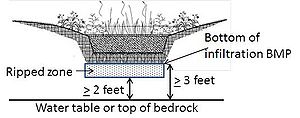
Difference between revisions of "Construction specifications for bioretention"
| Line 174: | Line 174: | ||
*once soil compaction becomes so severe that plants and soil microbes can no longer thrive, natural processes are no longer able to reduce soil compaction. | *once soil compaction becomes so severe that plants and soil microbes can no longer thrive, natural processes are no longer able to reduce soil compaction. | ||
| − | The most effective method for alleviating compaction is to add [[Turf#Compost|compost]] amendment. An additional technique for alleviating compaction is subsoiling or soil ripping. Ripping is most effective when used in conjunction with compost and/or sand amendment. | + | The most effective method for alleviating compaction is to add [[Turf#Compost|compost]] amendment. Other amendments, such as sand (in clay soils), can significantly reduce compaction since sandy soils are more resistant to compaction. An additional technique for alleviating compaction is subsoiling or soil ripping. Ripping is most effective when used in conjunction with compost and/or sand amendment. |
{{:Reported activities that restore or decrease soil bulk density}} | {{:Reported activities that restore or decrease soil bulk density}} | ||
Revision as of 19:09, 27 February 2014
The anticipated review period for this page is through March 2014
This page provides construction details, materials specifications and construction specifications for bioretention systems.
Contents
- 1 Construction details
- 2 Materials specifications - filter media
- 3 Construction specifications
- 4 References
- 5 Related pages
Construction details


CADD based details for bioretention are contained in the Computer-aided design and drafting (CAD/CADD) drawings section. The following details, with specifications, have been created for bioretention systems:
- Bioretention Facilities General Plan
- Bioretention plan-offline NEW
- Bioretention plan-online NEW
- Biofiltration planter - Plan NEW
- Bioretention parking median - Plan NEW
- Bioretention Facilities Performance Types Cross-Sections
- Bioinfiltration NEW
- Biofiltration with underdrain at the bottom NEW
- Biofiltration with elevated underdrain NEW
- Biofiltration with internal water storage NEW
- Biofiltration with liner NEW
- Biofiltration planter - Section NEW
- Bioretention parking median - Section NEW
- Cleanout NEW
- Underdrain valve NEW
- Biofiltration with elevated underdrain NEW
- Biofiltration with internal water storage NEW
- Biofiltration with underdrain at bottom NEW
- Bioinfiltration NEW
- Biofiltration with liner NEW
- Infiltration / Recharge Facility
- Filtration / Partial Recharge Facility
- Infiltration / Filtration / Recharge Facility
- Filtration Only Facility
Materials specifications - filter media
Filter media depth
Research has shown that minimum bioretention soil media depth needed varies depending on the target pollutant(s).
Minimum bioretention soil media depths recommended to target specific stormwater pollutants. From Hunt et al. (2012) and Hathaway et al., (2011). NOTE: The Construction Stormwater permit requires a 3 foot separation from the bottom of an infiltration practice and bedrock or seasonally saturated soils.
Link to this table
| Pollutant | Depth of Treatment with upturned elbow or elevated underdrain | Depth of Treatment without underdrain or with underdrain at bottom | Minimum depth |
|---|---|---|---|
| Total suspended solids (TSS) | Top 2 to 3 inches of bioretention soil media | Top 2 to 3 inches of bioretention soil media | Not applicable for TSS because minimum depth needed for plant survival and growth is greater than minimum depth needed for TSS reduction |
| Metals | Top 8 inches of bioretention soil media | Top 8 inches of bioretention soil media | Not applicable for metals because minimum depth needed for plant survival and growth is greater than minimum depth needed for metals reduction |
| Hydrocarbons | 3 to 4 inch Mulch layer, top 1 inch of bioretention soil media | 3 to 4 inches Mulch layer, top 1 inch of bioretention soil media | Not applicable for hydrocarbons because minimum depth needed for plant survival and growth is greater than minimum depth needed for hydrocarbons reduction |
| Nitrogen | From top to bottom of bioretention soil media; Internal Water Storage Zone (IWS) improves exfiltration, thereby reducing pollutant load to the receiving stream, and also improves nitrogen removal because the longer retention time allows denitrification to occur underanoxic conditions. | From top to bottom of bioretention soil media | Retention time is important, so deeper media is preferred (3 foot minimum) |
| Particulate phosphorus | Top 2 to 3 inches of bioretention soil media. | Top 2 to 3 inches of bioretention soil media. | Not applicable for particulate phosphorus because minimum depth needed for plant survival and growth is greater than minimum depth needed for particulate phosphorus reduction |
| Dissolved phosphorus | From top of media to top of submerged zone. Saturated conditions cause P to not be effectively stored in submerged zone. | From top to bottom of bioretention soil media | Minimum 2 feet, but 3 feet recommended as a conservative value; if IWS is included, keep top of submerged zone at least 1.5 to 2 feet from surface of media |
| Pathogens | From top of soil to top of submerged zone. | From top to bottom of bioretention soil media | Minimum 2 feet; if IWS is included, keep top of submerged zone at least 2 feet from surface of media |
| Temperature | From top to bottom of bioretention soil media; Internal Water Storage Zone (IWS) improves exfiltration, thereby reducing volume of warm runoff discharged to the receiving stream, and also improves thermal pollution abatement because the longer retention time allows runoff to cool more before discharge. | From top to bottom of bioretention soil media | Minimum 3 feet, with 4 feet preferred |
Performance specifications
The following performance specifications are applicable to all bioretention media.
- Growing media must be suitable for supporting vigorous growth of selected plant species.
- The pH range (Soil/Water 1:1) is 6.0 to 8.5
- Soluble salts (soil/Water 1:2) should not to exceed 500 parts per million
- All bioretention growing media must have a field tested infiltration rate between 1 and 8 inches per hour. Growing media with slower infiltration rates could clog over time and may not meet drawdown requirements. Target infiltration rates should be no more than 8 inches per hour to allow for adequate water retention for vegetation as well as adequate retention time for pollutant removal. The following infiltration rates should be achieved if specific pollutants are targeted in a watershed.
- Total suspended solids: Any rate is sufficient, 2 to 6 inches recommended
- Pathogens: Any rate is sufficient, 2 to 6 inches recommended
- Metals: Any rate is sufficient, 2 to 6 inches recommended
- Temperature: slower rates are preferable (less than 2 inches per hour)
- Total nitrogen (TN): 1 to 2 inches per hour, with 1 inch per hour recommended
- Total phosphorus (TP): 2 inches per hour
The following additional bioretention growing media performance specifications are required to receive P reduction credit.
- Option A - use bioretention soil with phosphorus content between 12 and 36 mg/kg per Mehlich III test
- Option B - include a soil amendment that facilitates adsorption of phosphorus
Guidance for bioretention media composition
Mix A: Water quality blend
A well blended, homogenous mixture of
- 60 to 70 percent construction sand;
- 15 to 25 percent top soil; and
- 15 to 25 percent organic matter.
- Sand: Provide clean construction sand, free of deleterious materials. AASHTO M-6 or ASTM C-33 washed sand.
- Top Soil: Sandy loam, loamy sand, or loam texture per USDA textural triangle with less than 5 percent clay content
- Organic Matter: MnDOT Grade 2 compost is recommended. (see also the section on Using Compost as a Soil Amendment
It is assumed this mix will leach phosphorus. When an underdrain is utilized a soil phosphorus test is needed to receive water quality credits for the portion of stormwater captured by the underdrain. The phosphorus index (P-index) for the soil must be low, between 10 and 30 milligrams per kilogram when using the Mehlich-3 test. This is enough phosphorus to support plant growth without exporting phosphorus from the cell.
Mix B: Enhanced filtration blend
A well-blended, homogenous mixture of
- 70 to 85 percent construction sand; and
- 15 to 30 percent organic matter.
- Sand: Provide clean construction sand, free of deleterious materials. AASHTO M-6 or ASTM C-33 washed sand.
- Top Soil in the mix will help with some nutrient removal, especially nutrients, but extra care must be taken during construction to inspect the soils before installation and to avoid compaction.
- Organic Matter: MnDOT Grade 2 compost is recommended. (see also the section on Using Compost as a Soil Amendment
It is assumed this mix will leach phosphorus. When an underdrain is utilized a soil phosphorus test is needed to receive water quality credits for the portion of stormwater captured by the underdrain. The phosphorus index (P-index) for the soil must be low, between 10 and 30 milligrams per kilogram when using the Mehlich-3 test. This is enough phosphorus to support plant growth without exporting phosphorus from the cell.
Mix C: North Carolina State University water quality blend (North Carolina Department of Environment and Natural Resources. 2009)
This mix is a homogenous soil mix of
- 85 to 88 percent by volume sand (USDA Soil Textural Classification);
- 8 to 12 percent fines by volume (silt and clay); and
- 3 to 5 percent organic matter by weight (ASTM D 2974 Method C) MnDOT Grade 2 compost is recommended.
A higher concentration of fines (12 percent) should be reserved for areas where nitrogen is the target pollutant. In areas where phosphorus is the target pollutant, a lower concentration of fines (8 percent) should be used. A soil phosphorus test using the Mehlich-3 method is recommended but not required to receive water quality credits. The phosphorus index (P-index) for the soil must be low, between 10 and 30 milligrams per kilogram. This is enough phosphorus to support plant growth without exporting phosphorus from the cell. It is assumed this mix will not exceed the upper range of recommended values (30 milligrams per kilogram), although at lower concentrations of organic matter a soil test may be needed to confirm there is adequate phosphorus for plant growth.
Mix D
Bioretention Soil Mix D soil shall be a mixture of coarse sand, compost and topsoil in proportions which meet the following:
- silt plus sand (combined): 25 to 40 percent, by dry weight
- total sand: 60 to 75 percent, by dry weight
- total coarse and medium sand: minimum of 55 percent of total sand, by dry weight
- fine gravel less than 5 millimeters: up to 12 percent by dry weight (calculated separately from sand/silt/ clay total)
- organic matter content: 2 to 5 percent, percent loss on ignition by dry weight; MnDOT Grade 2 compost is recommended.
- saturated hydraulic conductivity: 1 to 4 inches per hour ASTM F1815. Note that although this infiltration rate is generally applicable at 85 percent compaction, Standard Proctor ASTM D968, this is an infiltration rate standard and not a compaction standard. Therefore, this infiltration rate may be met at lower levels of compaction.
Suggested mix ratio ranges are
- Coarse sand: 50 to 65 percent
- Topsoil: 25 to 35 percent
- Compost (assuming MnDOT Grade 2 compost is being used): 10 to 15 percent
A soil phosphorus test using the Mehlich-3 method is recommended but not required to receive water quality credits. The phosphorus index (P-index) for the soil must be low, between 10 and 30 milligrams per kilogram. This is enough phosphorus to support plant growth without exporting phosphorus from the cell. It is assumed this mix will not exceed the upper range of recommended values (30 milligrams per kilogram), although at lower concentrations of organic matter a soil test may be needed to confirm there is adequate phosphorus for plant growth.
Comparison of pros and cons of bioretention soil mixes
Link to this table.
| Mix | Composition in original Manual | Proposed updated composition | Pros | Cons |
|---|---|---|---|---|
| A |
|
|
Likely to sorb more dissolved P and metals than mix B because it contains some fines; best for growth of most plants | Likely to leach P; if topsoil exceeds maximum allowed clay content, higher fines content could result in poor hydraulic performance and long drawdown times |
| B |
|
|
Easy to mix; least likely to clog | Likely to leach P, lack of fines in mix results in less dissolved pollutant removal; harder on most plants than mix A because it dries out very quickly |
| C | Not in original MN Stormwater Manual |
|
Likely to sorb more dissolved P and metals than mix B because it contains some fines; less likely to leach P than mix B because of low P content | Harder on most plants than mix A because it dries out very quickly. Research in Wisconsin indicates that in cold climates, excess of Na ions can promote displacement of Mg and Ca in the soil, which breaks down soil structure and decreases infiltration rate, and can also cause nutrient imbalances1 |
| D | Not in original MN Stormwater Manual |
|
Best for pollutant removal, moisture retention, and growth of most plants; less likely to leach P than mix B because of low P content | Harder to find. Research in Wisconsin indicates that in cold climates, excess of Na ions can promote displacement of Mg and Ca in the soil, which breaks down soil structure and decreases infiltration rate, and can also cause nutrient imbalances |
| E | Not in original manual |
|
High infiltration rates, relatively inexpensive | As compost breaks down, nutrients available for plants decreases |
| F | Not in original manual |
|
Finer particles in loamy sand holds moisture for better plant growth | Lower infiltration rates, requires careful soil placement to avoid compaction, requires custom mixing |
1This problem can be avoided by minimizing salt use. Sodium absorption ratio (SAR) can be tested; if the SAR becomes too high, additions of gypsum (calcium sulfate) can be added to the soil to free the Na and allow it to be leached from the soil (Pitt et al in press).
2MnDOT Grade 2 compost is recommended.
Other media
Several other media are currently being tested. A few examples are listed below.
Wisconsin peat moss replacement (Bannerman, 2013)
The following mix utilizes peat moss instead of compost.
- 12 percent peat moss
- 2 percent Imbrium Sorptive®MEDIA
- 86 percent sand
This mix aims to maximize phosphorus removal in 2 ways:
- substituting peat moss for compost, since peat moss has lower phosphorus content than compost and does not leach phosphorus; and
- including Sorptive®MEDIA to sorb phosphorus and minimize phosphorus in effluent
Construction specifications
Proper construction techniques are critical to achieve long-term functionality of bioretention systems. Construction sequencing is imperative; infiltration BMPs need to be installed as close to the end of construction as possible. Preferably, site slopes have been stabilized and the asphalt has been installed before the bioretention construction begins. However, this is not always possible in bioretention cells that are surrounded by a parking lot and are the only outlet for stormwater. In this case, excavate the bioretention cell during a period of dry weather. Install the underdrains, the outlet structure, and the media up to the proposed final elevation. Once the construction of the parking lot is complete, scrape off any silty or clayey confining layer that has accumulated on top of the media and remove it from the site and de-compact soil. Top up media to desired finished elevation. Mulch and plants (or sod if it is a grassed bioretention cell) may then be installed.
During construction it is critical to keep sediment out of the infiltration device as much as practicable. Utilizing sediment and erosion control measures, such as compost logs, check dams, and sediment basins, will help to keep bioretention cells from clogging. As soon as grading is complete, slopes should be stabilized to reduce erosion of native soils. If vegetated filter strips are used as pre-treatment, they must be vegetated as soon as possible following the completion of grading.
If the bioretention cell has sod specified for its cover (as opposed to tree/shrub/mulch systems), the sod must be either 1) grown on sandy underlying soils or 2) be washed sod. Washed sod has had all soil removed from the roots, which prevents the sod layer from restricting infiltration into the underlying media. It also typically roots more quickly than standard sod.
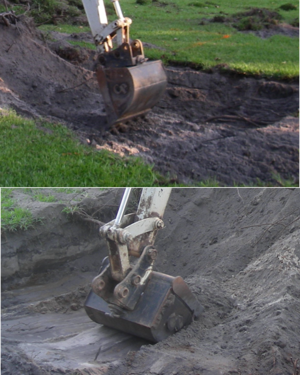
Preventing and alleviating compaction are crucial during construction of infiltration practices, as compaction can reduce infiltration rates in sandy soils by an order of magnitude and in clayey soils by a factor of 50 (Pitt et al. , 2008). Therefore, it is critical to keep heavy construction equipment from compacting or smearing soils at the bottom of the excavation. Excavate the soil from the perimeter of the infiltration device. Tracked vehicles should be used to reduce the pressure placed on the soil. It is highly recommended to excavate during dry conditions to prevent smearing of the soil, which has been shown to reduce the soil infiltration rate (Brown and Hunt, 2010). Driveable mats can be used for backfill and grading to minimize compaction. During the final pass with the excavator bucket (i.e. bottom of excavation), it is highly recommended to rake the soil with the teeth of the bucket to loosen any compaction (Brown and Hunt, 2010). Smooth bucket blades smear soils and restrict infiltration rates. Soil ripping has also been shown to increase infiltration and reduce compaction from construction activities (Tyner et al., 2009; Wardynski et al., 2013).
Given that the construction of bioretention practices incorporates techniques or steps which may be considered non-traditional, it is recommended that the construction specifications include the format and information discussed below.
Temporary erosion control
- It is REQUIRED that future bioretention locations not be used as temporary sedimentation basins unless 3 feet of cover is left in place during construction.
- If the bioretention area is excavated to final grade (or within 3 feet of) it is REQUIRED that rigorous erosion prevention and sediment controls (e.g. diversion berms) are used to keep sediment and runoff completetly away from the bioretention area.
- Install prior to site disturbance
- Protect catch basin/inlet
- Cover erodible surfaces, for example with plastic covers, that can be re-used.
Excavation, backfill and grading
- It is HIGHLY RECOMMENDED that prior to beginning the installation, sufficient material quantities shall be onsite to complete the installation and stabilize exposed soil areas without delay.
- It is HIGHLY RECOMMENDED that excavation, soil placement and rapid stabilization of perimeter slopes be completed before the next precipitation event
- Timing of grading of infiltration practices relative to total site development
- Use of low-impact, earth moving equipment (wide track or marsh track equipment, or light equipment with turf-type tires)
- Do not over-excavate
- Restoration in the event of sediment accumulation during construction of practice
- Alleviate any compacted soil (compaction can be alleviated at the base of the practice by using a primary tilling operation such as a chisel plow, ripper or sub-soiler to a minimum 12 inch depth
- Gravel backfill specifications
- Gravel filter specifications
- Filter fabric specifications
Alleviating compaction resulting from construction
Alleviation of compaction of disturbed soil is crucial to the installation of successful vegetated stormwater infiltration practices. Typical bulk densities for non-compacted soils are in the range of 1.0 to 1.50 grams per cubic centimeter. Urban soils typically have bulk densities greater than this. Construction activities can increase bulk densities by 20 percent or more. The compaction can extend up to two feet into the soil profile, often resulting in bulk densities that do not readily support healthy plant growth.
Comparison of bulk densities for undisturbed soils and common urban conditions. (Source: Schueler, T. 2000. The Compaction of Urban Soils: Technical Note #107 from Watershed Protection Techniques. 3(2): 661-665. Center for Watershed Protection, Ellicott City, MD.)
For information on alleviating soil compaction, see Alleviating compaction from construction activities
Link to this table
| Undisturbed soil type or urban condition | Surface bulk density (grams / cubic centimeter |
|---|---|
| Peat | 0.2 to 0.3 |
| Compost | 1.0 |
| Sandy soil | 1.1 to 1.3 |
| Silty sands | 1.4 |
| Silt | 1.3 to 1.4 |
| Silt loams | 1.2 to 1.5 |
| Organic silts / clays | 1.0 to 1.2 |
| Glacial till | 1.6 to 2.0 |
| Urban lawns | 1.5 to 1.9 |
| Crushed rock parking lot | 1.5 to 2.0 |
| Urban fill soils | 1.8 to 2.0 |
| Athletic fields | 1.8 to 2.0 |
| Rights of way and building pads (85% compaction) | 1.5 to 1.8 |
| Rights of way and building pads (95% compaction) | 1.6 to 2.1 |
| Concrete pavement | 2.2 |
| Quartzite (rock) | 2.65 |
Increase in soil bulk density as a result of different land uses or activities.
Link to this table
| Land use or activity | Increase in bulk density (grams / cubic centimeter | Source (link to Reference list) |
|---|---|---|
| Grazing | 0.12 to 0.20 | Smith, 1999 |
| Crops | 0.25 to 0.35 | Smith, 1999 |
| Construction, mass grading | 0.34 to 0.35 | Randrup, 1998; Lichter and Lindsey, 1994 |
| Construction, no grading | 0.20 | Lichter and Lindsey, 1994 |
| Construction traffic | 0.17 to 0.40 | Lichter and Lindsey, 1994; Smith, 1999; Friedman, 1998 |
| Athletic fields | 0.38 to 0.54 | Smith, 1999 |
| Urban lawn and turf | 0.30 to 0.40 | Various sources |
While natural processes can alleviate soil compaction, additional techniques to alleviate soil compaction are often desirable because
- it can take many years for natural processes to loosen up soil;
- natural processes operate primarily within the first foot or so of soil, and compaction from development can extend to two feet deep; and
- once soil compaction becomes so severe that plants and soil microbes can no longer thrive, natural processes are no longer able to reduce soil compaction.
The most effective method for alleviating compaction is to add compost amendment. Other amendments, such as sand (in clay soils), can significantly reduce compaction since sandy soils are more resistant to compaction. An additional technique for alleviating compaction is subsoiling or soil ripping. Ripping is most effective when used in conjunction with compost and/or sand amendment.
Reported activities that restore or decrease soil bulk density
Soil ripping
The goal of soil ripping or subsoiling is to fracture compacted soil without adversely disturbing plant life, topsoil, and surface residue. Soil compaction occurs most frequently with soils having a high clay content. Fracturing compacted soil promotes root penetration by reducing soil density and strength, improving moisture infiltration and retention, and increasing air spaces in the soil. Compacted layers typically develop 12 to 22 inches below the surface when heavy equipment is used. Conventional cultivators cannot reach deep enough to break up this compaction. Subsoilers (rippers) can break up the compacted layer without destroying soil aggregate structure, surface vegetation, or mixing soil layers (Kees, 2008).
How effectively compacted layers are fractured depends on the soil's moisture, structure, texture, type, composition, porosity, density, and clay content. Success depends on the type of equipment selected, its configuration, and the speed with which it is pulled through the ground. No one piece of equipment or configuration works best for all situations and soil conditions, making it difficult to define exact specifications for subsoiling equipment and operation.
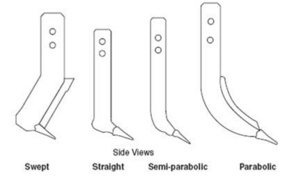
Subsoilers are available with a wide variety of shank designs. Shank design affects subsoiler performance, shank strength, surface and residue disturbance, effectiveness in fracturing soil, and the horsepower required to pull the subsoiler. According to Kees (2008), “Parabolic shanks require the least amount of horsepower to pull. In some forest applications, parabolic shanks may lift too many stumps and rocks, disturb surface materials, or expose excess subsoil. Swept shanks tend to push materials into the soil and sever them. They may help keep the subsoiler from plugging up, especially in brush, stumps, and slash. Straight or "L" shaped shanks have characteristics that fall somewhere between those of the parabolic and swept shanks.”
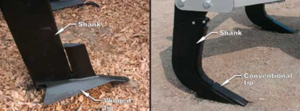
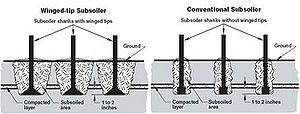
Shanks are available with winged tips and conventional tips. Winged tips cost more than conventional tips and require more horsepower, but can often be spaced farther apart. Increasing wing width also increases critical depth – the depth below which little soil loosening occurs (Owen 1987, Spoor 1978). Using shallow leading tines ahead of deeper tines also increases required shank spacing (Spoor 1978). According to Kees (2008), the shank’s tip should run to a depth of 1 to 2 inches below the compacted layer. Kees (2008) also recommends making sure that the shanks on the subsoiler are spaced so that they run in the tracks of the tow vehicle, because the equipment used to pull subsoilers is heavy enough to create compaction itself.
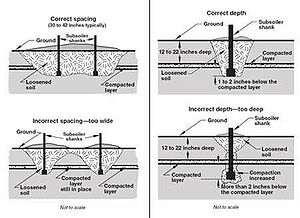
Kees (2008) recommends following ground contours whenever possible when subsoiling to “increase water capture, protect water quality, and reduce soil erosion.” He also states that “in some cases, two passes at an angle to each other may be required to completely fracture compacted soil.” Spoor and Godwin (1978) also found that “Relatively closely spaced tines, staggered to prevent blockage, are more efficient at producing complete loosening than repeated passes with tines at wider spacings.”
Soils should be mostly dry and friable. Urban (2008) describes ideal conditions for compaction reduction as follows: “soil moisture must be between field capacity and wilt point during compaction reduction for maximum effectiveness.
Always know where utilities are buried prior to subsoiling. Avoid subsoiling in area that have buried utilities, wires, pipes, culverts, or diversion channels (Kees 2008, Urban 2008).
Soil ripping will generally be more effective with the addition of an amendment. This can be either sand or compost. Tilling in compost amendment may not be desirable on sites with steep slopes, a high water table, wet saturated soils, or downhill slope toward a house foundation (Schueler Technical Note #108) or where there are tree roots or utilities, or where nutrients leaching from compost would pose a problem. Since soil restoration techniques will need to be tailored to site conditions, a prescriptive soil restoration specification is not recommended. However, Pennsylvania, Virginia, and Washington State have specifications for soil amendment and restoration and these may be used as guidance in determining how to amend a compacted soil.
Cost for subsoiling varies by project. The Pennsylvania Stormwater Best Management Practices Manual estimates the cost of tilling soils ranges from $800 to $1000 per acre, while the cost of compost amending soil is about the same.
Recommendations for soil ripping to alleviate compaction
For basins larger than 1000 square feet, if compaction is above ideal bulk density indicated in the table below the soil should be remediated as follows:
- Rip to a depth of 18 inches where feasible
- For clay subsoil, incorporate 2 inches of sand. For bioretention without an underdrain, MnDOT Type 2 compost may be incorporated instead of sand.
- Maintain a 3 foot minimum separation distance between the bottom of the infiltration practice and the seasonally high water table or bedrock. If soil ripping is utilized, the requirement is a 2 foot minimum between the bottom of the ripped zone and a 3 foot minimum from the bottom of the infiltration practice to the water table or top of bedrock. If there is only a 3 foot separation distance between the bottom of the infiltration practice and the elevation of the seasonally high water table or bedrock, limit ripping depth to 1 foot (12 inches).
General relationship of soil bulk density to root growth based on soil texture
Link to this table
| Soil texture | Ideal bulk densities (g/cm3) | Bulk densities that may affect plantgrowth (g/cm3) | Bulk densities that restrict root growth (g/cm3) |
|---|---|---|---|
| sands, loamy sands | <1.60 | 1.69 | >1.80 |
| sandy loams, loams | <1.40 | 1.63 | >1.80 |
| sandy clay loams, loams, clay loams | <1.40 | 1.60 | >1.75 |
| silts, silt loams | <1.30 | 1.60 | >1.75 |
| silt loams, silty clay loams | <1.40 | 1.55 | >1.65 |
| sandy clays, silty clays, clay loams with 35-45% clay | <1.10 | 1.49 | >1.58 |
| clays (>45% clay) | <1.10 | 1.39 | >1.47 |
Native plants, planting and transplanting
Vigorous plants are crucial to the bioretention system’s long term stormwater performance. Plant roots help soil particles form stable aggregates, improve soil structure, maintain and increase water storage and infiltration capacity, as well as improve stormwater pollutant removal. Specific stormwater benefits include the following.
- Crucial to Long Term Infiltration: As plant roots grow and then decay, they restore and/or enhance soil porosity and infiltration rates. Deeper rooted plants yield higher infiltration rates than shallow rooted plants. Bioretention practices with native prairie plants will typically have greater infiltration rates, deeper rooting depths, greater biological activity of flora and fauna, and deeper drainage compared to turf systems.
- Crucial to Water Quality Benefits: Plants in bioretention systems have been shown to improve dissolved nutrient removal, improve hydrocarbon removal and aid TSS sequestration.
- Interception and Evapotranspiration: Woody vegetation typically intercepts and evapotranspires significantly more water than herbaceous vegetation, and large trees intercept and evapotranspire significantly more rain than small trees
Construction considerations include the following.
- timing of native seeding and native planting;
- weed control; and
- watering of plant material.
Construction sequence scheduling
- Temporary construction access
- Location of temporary sediment and erosion control practices to protect BMPs and downstream receiving waters
- Removal and storage of excavated material
- Installation of underground utilities
- Rough grading
- Seeding and mulching disturbed areas
- Road construction
- Final grading
- Site stabilization
- Installation of semi-permanent and permanent erosion control measures
- Removal of temporary sediment and erosion control devices
Construction observation
- Adherence to construction documents
- Verification of physical site conditions
- Erosion control measures installed appropriately
References
- Brown, R.A. and Hunt, W.F. (2010). Impacts of construction activity on bioretention performance. Journal of Hydrologic Engineering. 15(6), 386-394.
- Chaplin, Jonathan, Min Min, and Reid Pulley. 2008. Compaction Remediation for Construction Sites. Final Report. Department of Bioproducts and Biosystems Engineering, University of Minnesota, St. Paul,Minnesota.
- Cogger, C. 2005. Potential Compost Benefits for Restoration of Soils Disturbed by Urban Development. Compost Science & Utilization. 13.4:243-251.
- Hanks, Dallas, and A. Lewandowski, 2003. Protecting Urban Soil Quality: Examples for Landscape Codes and Specifications. USDA Natural Resources Conservation Services.
- Kees, Gary. 2008. Using Subsoiling To Reduce Soil Compaction. U.S. Forest Service Technology & Development Publication 3400 Forest Health Protection 0834-2828-MTDC.
- NRCS. 1998. Soil Quality Test Kit Guide.
- Olson, Nicholas Charles. 2010. Quantifying the Effectiveness of Soil Remediation Techniques in Compact Urban Soils. University Of Minnesota Master Of Science Thesis.
- Owen, Gordon T. 1987. Soil disturbance associated with deep subsoiling in compact soils. Canadian Agricultural Engineering: 33-37.
- Pennsylvania department of Environmental Protection. 2006. Pennsylvania Stormwater Best Management Practices Manual. BMP 6.7.3: Soil Amendment & Restoration. 2006.
- Pitt, R., Chen, S., Clark, S.E., Swenson, J., and Ong, C.K. 2008. Compaction’s impact on urban storm-water infiltration. Journal of Irrigation and Drainage Engineering. 134(5):652-658.
- Schueler, T. 2000. The Compaction of Urban Soil: The Practice of Watershed Protection. Center for Watershed Protection, Ellicott City, MD. pp. 210-214.
- Schueler, T. R. Can Urban Soil Compaction Be Reversed? Technical Note #108 from Watershed Protection Techniques. 1(4): 666-669.
- Selbig, W.R., and N. Balster. 2010. Evaluation of turf-grass and prairie-vegetated rain gardens in a clay and sand soil: Madison, Wisconsin, water years 2004–08. U.S. Geological Survey, Scientific Investigation Report 2010–5077, 75 p.
- Spoor, G. & Godwin, R.J. 1978. An experimental investigation into the deep loosening of soil by rigid tines. Journal of Agricultural Engineering Research, 23, 243–258.
- Spoor, G., Tijink, F.G.J. & Weisskopf, P. 2003. Subsoil compaction: risk, avoidance, identification and alleviation. Soil and Tillage Research,73, 175–182.
- Spoor, G. 2006. Alleviation of Soil Compaction: Requirements, Equipment and Techniques. Soil Use and Management 22:113-122.
Related pages
- Overview for bioretention
- Types of bioretention
- Design criteria for bioretention
- Construction specifications for bioretention
- Operation and maintenance of bioretention
- Cost-benefit considerations for bioretention
- External resources for bioretention
- References for bioretention
- Requirements, recommendations and information for using bioretention BMPs in the MIDS calculator
